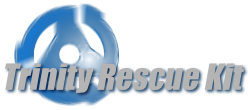Instead of running programs on your computer using Windows, you are now starting your computer with something completely different. Trinity Rescue Kit is not designed to give you the same environment you get normally, but to provide you the means and the utilities to perform rescue and repair operations that might not be (anymore) possible on your computer in normal Windows operation mode.
Because this is Linux, you will not see your drives in the same way you do under Windows (or DOS), but they will appear as logically assigned devices. So instead of the C:-drive, you will get /dev/hda1 in which ‘hda’ is your first available harddisk (‘h’ in hda is for ide drives, ‘s’ is for scsi, sata and removable drives), hda1 is the first (primary) partition on which a filesystem may reside. The filesystem used in general for Windows is NTFS. This stands for New Technology FileSystem, but in the mean time the “New” in technology is already more than 12 years old. Nevertheless, it has gotten some improvements over the years and it is, I must admit, a good filesystem. The other filesystem natively supported by Windows is FAT, which come in the flavors FAT12 (for floppies), FAT16 (for small disks up to 2Gb) and FAT32 (for bigger disks).
What ‘s also different from Windows is that these filesystems are not accessible by default in Linux, you have to so called “mount” them. Where in Windows you will get a drive C: with your files on, in Linux you have to call the command ‘mount’ and mount the filesystem against a subdirectory. An example of this: let ‘s say your drive C: is /dev/hda1 (/dev contains the collection of device references on your system). You have a directory /mnt0. In this case you type ‘mount /dev/hda1 /mnt0’. When you invoke the command ‘mount’ afterwards without any parameters, you will see that /dev/hda1 is mounted on /mnt0. If you cd to that directory and type ‘ls’ (=equivalant of ‘dir’ in Windows), you will get a directory listing of what ‘s available on that C: drive.
Now with this all explained, you should see the picture: TRK runs on your computer but treats it as a doctor inspecting a dead body: everything is there, but the person is not. You can now perform surgery on the body and try to revive it.
